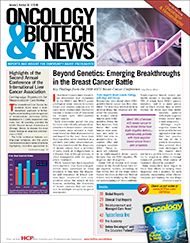Promising New Regimen for Head and Neck Cancers
Clinicians from various centers across the nation collaborated in conducting a multicenter phase II trial that assessed the feasibility, toxicity,and possible efficacy of a short-term treatment regimen prior to surgery for squamous-cell head and neck carcinoma (SCHNC).
Click here to view as PDF.
Individuals with squamous-cell head and neck carcinoma (SCHNC) generally demonstrate significant cellular immune suppression, which can worsen a poor prognosis. SCHNC is primarily treated with surgical excision, and there is currently no consensus on effective neoadjuvant therapy. Clinicians from various centers across the nation collaborated in conducting a multicenter phase II trial that assessed the feasibility, toxicity, and possible efficacy of a short-term treatment regimen prior to surgery for SCHNC that included citoplurikin (IRX-2). Citoplurikin is a biological response modifier comprised of interleukin- 1, interleukin-2, interferon-gamma, and other cytokines.
The trial enrolled 27 patients with newly diagnosed advanced squamous cell tumors in the oral cavity (n = 15), oropharynx (n = 8), larynx (n = 3), or hypopharynx (n = 1). Ninety percent of these patients suffered from stage III or stage IV disease. Patients were matched to 81 controls who underwent surgical resection but did not receive the therapy regimen being studied.
The patients in the therapy group received a 21-day regimen that consisted of intravenous (IV) cyclophosphamide (300 mg/m²) on day 1 followed by bilateral perilymphatic injections of citoplurikin on days 4 to 15, with oral indomethacin, zinc, and omeprazole administered on all 21 days. Surgery was performed 22 to 47 days after completion of therapy.
Median follow-up was 15 months. Objective tumor response was seen in 16% of patients, and tumor size was reduced or stabilized in 74%. Significant changes in tumor and lymph node lymphocytic infiltration was found with the citoplurikin regimen. According to the investigators, the estimated 2-year overall survival rate of 72% and the disease-free survival rate of 67% were significantly greater than the rates observed in the control group.
Patients who received citoplurikin treatment experienced toxicities that were generally <grade 2. The following serious adverse events (grade 3 or 4), however, were observed within 30 days of therapy: aspiration pneumonia (n = 3), alcohol withdrawal (n = 1), upper respiratory infection (n = 1), wound infection (n = 1), and asthma (1).
Citoplurikin therapy shows promise in terms of increased tumor lymphocyte infiltration, objective tumor and fibrosis response, and positive overall survival data. Additionally, the agent was well tolerated. Researchers will continue evaluating citoplurikin in a phase III study (INSPIRE).
Wolf GT, Fee WE, Dolan R, et al. New paradigm for the treatment of head and neck cancer. Paper presented at: 7th International Conference on Head and Neck Cancer; July 22, 2008; San Francisco, CA.




